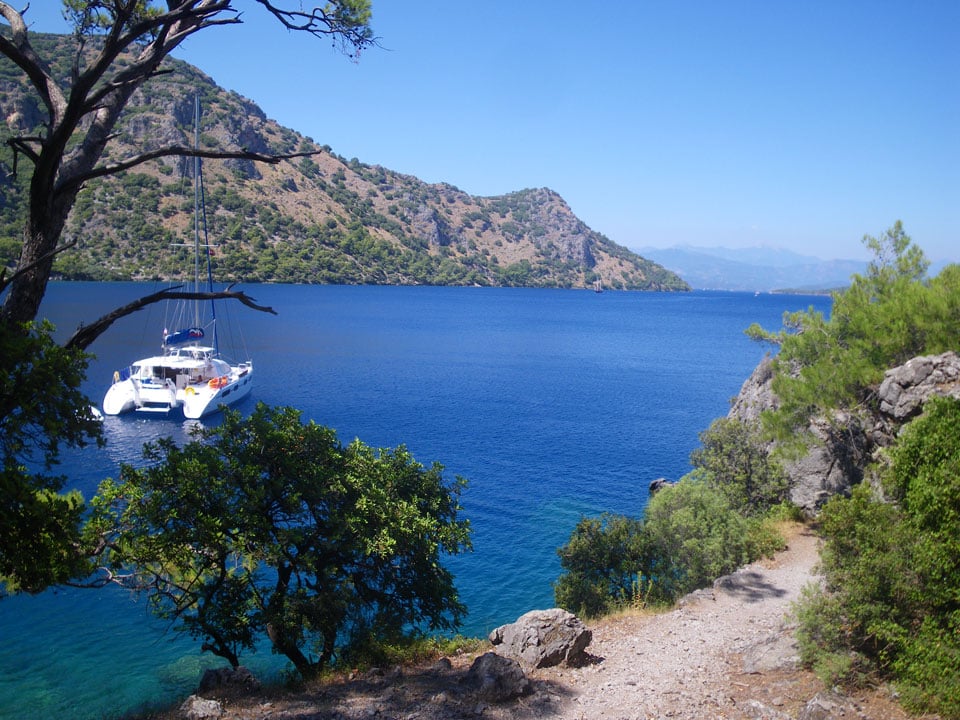
Turkey Charter
The voice came out of a confusing swarm of line handlers. The words were familiar, but the overall effect was as different to my ears as the muezzin’s frequent call to prayer. We were in Turkey, and two tasks so familiar—docking and dinner—made me, an experienced charterer, confused, tense, and anxious.
“Lady! Lady! You dine with us tonight!” the smartly uniformed marina worker called to me. “Your table is set. We have the best restaurant, best bar, best swimming pool, best spa.”
He then plopped menus and rate cards for the local hamam, the renowned Turkish variant on the steam bath that also offers massages, in my hands.
Dinner and a bath and a massage?
I looked around. We’d scrambled to get our double-wide load, the Moorings 4600 cat Therapy, into a spot. It was a delicate dance of line handling and deft helmsmanship. All were handled flawlessly by our crewmates, friends I’d asked to join my other half, Rick Martell, and me on this adventure because of their fun-loving attitude, energy, and expert ways with sailboats.
The place we picked was Yacht Classic Hotel on the waterfront of Fethiye, our destination after a daylong downwind reach from Ecinçik, some 32 miles west on Turkey’s Lycian coast. We chose Fethiye after a few days of sailing the islands and coastal anchorages during the hot eastern Mediterranean summer of 2011 for several reasons. We needed water, had trash to toss, and one member, yours truly, needed an Internet connection—bad.
My crew was easygoing, but I was hot, sweaty, and trying to meet a deadline. And I probably wasn’t thinking too clearly, because I couldn’t decide if I wanted to spend the money and stay the night.
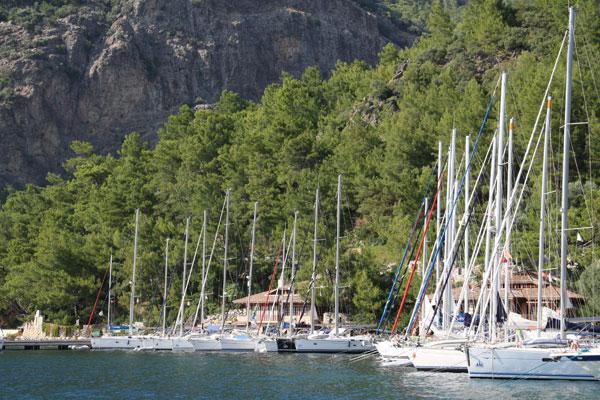
Rick Martell
That’s where the cross-cultural exchange hit the pothole of miscommunication.
Me: “How much does it cost to stay? What if we don’t stay overnight?”
He: “Lady, of course you stay. Look at our restaurant.”
Me: “But we don’t want the restaurant.”
He: “Lady, you pay the same, whether you stay four hours or you stay overnight.”
Somehow that translated into 50 Turkish lira (about $28) to me and, a few hours later, 150 TL (about $84) to them. The drift from our hosts was either you’re here, tied to our dock, and dining with us, like sultans and pashas, nibbling on eggplant and yogurt dip and grilled lamb kebobs. Or not.
After much to and fro and a few more words, “Lady” learned a lesson about “the system” (you dine, they forgo dockage fees) and paid my bill.
A Different Destination
Taking a trip to Turkey is like taking a trip to Mars.
There’s the recurrent call to prayer, which, droning out of electric speakers, can sound, to inexperienced ears, like the buzz of a mosquito. There’s the inscrutable language that, to ears and eyes more used to the Romance languages, yields scant clues to comprehension. There’s the dress: Why are some women covered head to toe, why are some in high heels, why are some in both? And public toilets I get, but public baths, with massages? And tombs cut into rocky hillsides, ruins tumbling down to the shore?
You sure don’t find these in the British Virgin Islands. Turkey is a challenge set a rung or two higher on the charter scale than the B.V.I. It’s a big adventure in a different kind of cruising ground—and totally worth it.
And, hey, it’s not that hard.
True, the meltemi blows. But on long, sunny days along the Lycian coast, it’s possible to work with this wind blowing from the west, instead of against it. Med mooring does become second nature, whether you’re using laid lines for the bow or tying a stern line ashore to a bollard or a rock. And the region south of our departure point, The Moorings base in Göçek, is so full of coves and secluded bays and protected indentations that finding friendly water is no big deal. That’s true even in July, a month that, according to conventional wisdom, is marred by vacationing European crowds. (However, in August, a monthlong break for many Europeans, all bets are off.) As for the locals, it’s a point of pride, taken very seriously, that visitors must have a good time. Enjoy it.
How did it all begin? Rave reviews from sailors who’d already cruised in Turkey made me curious. During my visit to her Vermont home, famed solo circumnavigator Tania Aebi showed off a beautiful multicolored glass lamp and a pouch of spices she brought back after a flotilla she’d led here. “Bring a shopping bag for the bazaar!” she advised.
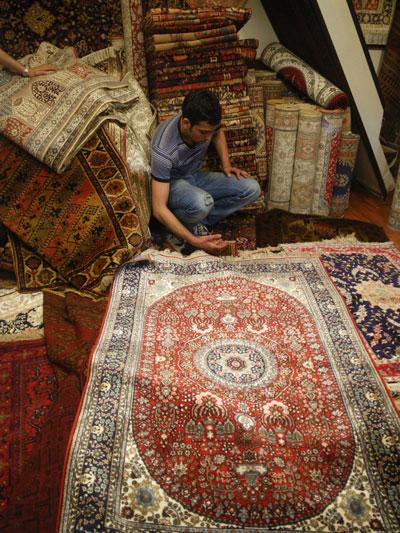
Pat Manion
Veteran bluewater voyager Liza Copeland, who cruised in Turkey and the rest of the Med aboard her own boat, Bagheera, dished out advice on kilim, or carpet, buying. “Measure out your home’s floor spaces before you leave!”
And don’t forget to drink the fresh-squeezed pomegranate juice! That was the tip from colleagues Peter and Carol King, charter-vacation brokers and partners in CW‘s Adventure Charter program. They’d recently returned from a trip they led aboard a Turkish gulet, one of the many traditional wooden double-masted motorsailers that carry guests to destinations along the country’s coast and among its islands.
With those admonitions came Turkish tourism department-issued descriptors: center of world history, cradle of civilizations, seat of the Roman, Byzantine, and Ottoman empires, last home of the Virgin Mary, presenter of coffee to the West.
But what does a cradle of ancient civilization and a continental crossroads look and feel like? How does it taste? How does a rising world economic player mostly situated in Asia and a secular democratic republic whose population of some 78 million is 99 percent Muslim comport itself? And what can an American celebrating the Fourth of July look forward to while visiting a country that is awaiting membership in the European Union while sharing borders with Armenia, Azerbaijan, Bulgaria, Georgia, Greece, Iran, Iraq, and Syria?
For answers to these heady East-West questions before I got there to check it out firsthand, I consulted the work of Rod Heikell, who’s been cruising throughout the Med for decades and is unparalleled in his passion for the region. Heikell publishes and regularly updates a series of detailed guides and pilots of countries and destinations there.
While cruising and researching his books over the decades, he’s documented the growth of Turkey’s infrastructure and economy as it relates to the proliferation of tourism and waterfront development, including the marine service sectors and yacht chartering.
As Turkey pushes to become a full member of the E.U., he writes, it would be “the first country with a majority Muslim population in this predominantly Western and Christian club.” Sailors venturing to the east Aegean should bear in mind that “for those of us who have cruised and traveled in Turkey, the fears are paper thin, and the country, more like the West than not, is a most gentle of introductions to the Muslim world.”
Under Way and In Touch
Fast-forward to July 1 and Göçek, a yachtie village on the southwest coast. The Moorings base and its 36-strong fleet of monohulls and multihulls is situated at Club Marina, a bit removed from a waterfront lined with gulets and charter fleets on one side and markets, tour companies, and cafés and restaurants doing a brisk business on the other.
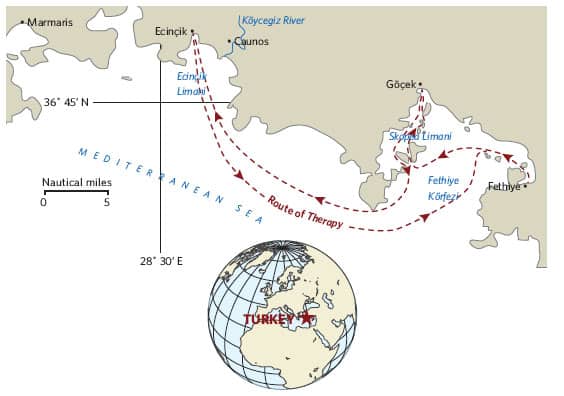
Manager Deniz Aydin runs a tight ship; in an efficient, formal, yet friendly style, he guided us through a thorough technical briefing of Therapy, a 46-foot cat with four cabins and four heads designed by Morrelli & Melvin and built by a South African company, Robertson and Caine, expressly for The Moorings charter fleet.
Therapy throughout the week proved it could execute its focused mission flawlessly. With a spacious, 24-foot beam, it afforded privacy yet doled out ample areas for congregating. The sails went up smoothly on halyards powered by two-speed winches and quickly filled with wind, the clicker on the stove always ignited a burner flame, and on the few occasions that we succumbed to the air-conditioning, we didn’t freeze to death. Heaven.
No weeklong charter ever translates into seven solid days under way. And given the crew’s appetite for everything from ruin sightseeing, rock climbing, kayaking (we’d ordered a pair of singles), snorkeling, and swimming to vittles themselves, we chose to load the boat up with provisions and forgo dining ashore nightly—hence our hesitation when we arrived in Fethiye, and the lively discussion that ensued—in favor of anchorages that enticed us with clear, cool water, scents of rosemary and thyme, shade from long-needle pines, and majestic ruins nestled among rocky hillsides dotted with oleander and stands of olive trees.
After poring over charts and guides last winter and listening to Deniz describe the features of the region at the briefing, we came up with a general route that allowed us to explore anchorages south of Göçek in Skopea Limani and Fethiye Körfezi, the gulf of Fethiye, before heading beyond, into the eastern Aegean Sea.
Time spent bobbing along the coves and bays of Skopea Limani helped crew and boat get acquainted with each other and with the sailing grounds that were new to all of us. Not all our crewmates had met each other before this trip, and the charter set the stage for new friendships to form easily.
Our traits and desires jelled well together pretty naturally. The kayakers were the ones who usually got up early in the morning and put on the coffee; the chocolate addicts had ample and tasty stashes they shared.
Athletic Sue Areson swam our stern lines ashore (watch the video here); racer Carrie Fletcher excelled at sensible thinking in sailing maneuvers; and though she really needed a break from her round-the-clock master’s-degree pursuits to become a nurse-practitioner, everyone was grateful for Jane Kopacki’s excellent first-aid skills.
We left the protected waters of Skopea Limani one day about midmorning, though given the meltemi’s fairly reliable gathering of strength as the hours progress, a smarter move would’ve been to weigh anchor at dawn. After an adventurous slog 30 miles northwest, we spent a couple of days anchored at Ecinçik Limani, off My Marina, a full-service resort and five-star restaurant.
That gave us time to leave Therapy for the day and hire a tour boat helmed by Sezgin Kaplan, whom we nicknamed Captain No Problem for his easy, accommodating way. He took us up the Köycegiz River inland several miles to visit the ruins of the sixth-century city of Caunos and the nearby modern village of Dalyan. We also took dips into nearby mud baths and sulfur springs, an outing we found to be oversold, considering the hordes of folks who were bussed in from nearby resorts to the Disney-like site.
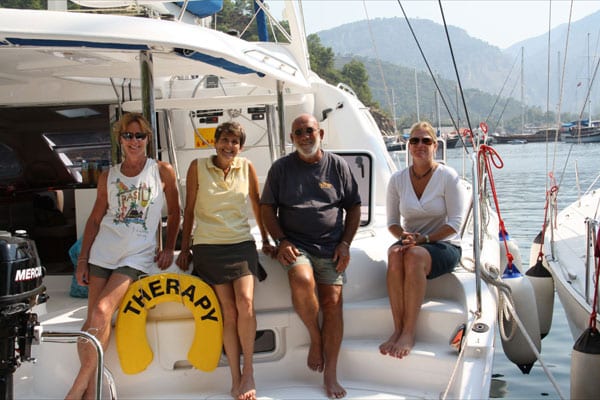
Pat Manion
Once we’d felt the minerals had done miracles for our skin, and we’d sampled the bar drinks at the My Marina restaurant a couple of times, we were ready the next morning to point the bows southwest for the 30-mile run—accompanied by the appearance of dolphins at lunchtime—to Fethiye, before dawdling again among the unforgettable anchorages of Skopea Limani.
All the while, “Lady” was fielding feedback from CW‘s online community—this was my first interactive bareboat charter. Armed with a laptop and an iPhone, I posted pictures and comments several times a day to the CW Facebook page while en route, giving our location and describing our surroundings.
Windtraveler was envious: “Oh!! We would love to cruise in Turkey!!”
Lois Joy Hofmann: “The city of Caunos was great, even though it rained when we trudged through, back in 2007 during our circumnavigation on Pacific Bliss.”
And Bob Sandberg offered up this perspective: “Found Yacht Classic marina to be very fair and reasonably priced. They had great facilities (showers, wonderful pool) and extremely helpful and pleasant staff. Would give Yacht Classic two thumbs up.” Point taken. Lady stands duly informed.
Good Therapy
Just how perfect, how idyllic was each anchorage along the way? How exhilarating were the views of the imposing ochre Taurus Mountains while sailing or after taking bracing hillside climbs among the remains of distant civilizations? How relaxing was it to hear out of the predominant silence little but the tinkling of bells around the necks of goats that nudged themselves along precipitous crevices?
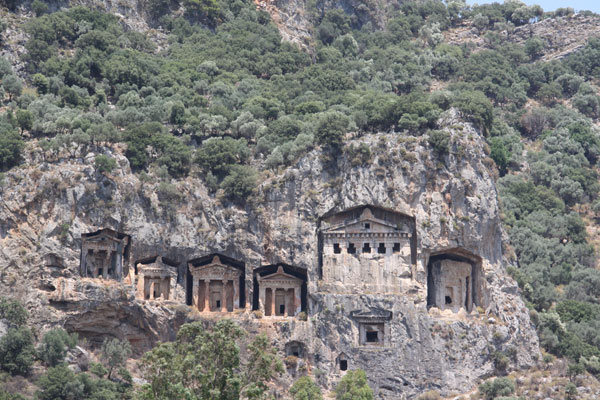
Rick Martell
The truth, of course, is that each stop and every outing was all that. What actually caused the most consternation and, admittedly, another cultural disconnect was when we tried to distinguish nomenclature variations and spelling mistakes that lurk in the government-issued paper charts and in the electronic software and square them with names in Heikell’s guides. It made me wonder why the base didn’t just print up its own chart with Heikell’s terminology and pass it out to charterers before their departure.
Ortism Buku, our anchorage on the first night of the charter, is called “Gunlukluk Koyu” on the charts. The lively exchange among guide- and chart-wielding crewmembers while hovered over the electronic-chart readout at the nav station also built up our appetites. So none of us protested when we heard the cry “Pancakes! Pancakes! Pancakes!” from the husband-and-wife couple who puttered from anchorage to anchorage not just selling but also kneading the dough and quick-frying before our eyes the thin crusts they filled with everything from chocolate and bananas to cheese, potatoes, and spinach.
Heikell’s Wall Bay and Ruin Bay (Ruin Bay is also known as Cleopatra’s Bay, a legendary meeting place for the queen and Mark Antony) are “Kapi Koyu” and “Hamam Koyu” on the charts. We may have been tongue-tied trying to pronounce those names, but it didn’t get in the way of our anchoring there, deploying the kayaks, and exploring ruins that seem to tumble into the water.
And Tomb Bay, a place I cherish for the climb we made to its stone vaults tucked in the hillsides, is “Tasyaka” in Heikell. On the charts, it’s “Siralibuk Koyu.”
Attribute those quirks to modifications and name changes over time, explains Heikell, who uses Turkish modern and common names with old names and variations on those names contained in brackets in his guides. Too bad the charts, created by Turkish hydrographic departments, don’t do the same. We figured it out and got by, though it left me wondering if I should’ve taken a stab at the language, part of the Ural-Altaic group and related to Finno-Hungarian tongues.
“Knowing Turkish doesn’t necessarily help with understanding when it comes to place names, sailing jargon, and idioms,” Joseph Curtis assured me. I met Joe and Oya Ünal-Curtis, his Turkish wife, on the last night of our charter, after dinner at the restaurant at the Kapi Creek anchorage.
Joe and Oya were with a large group; it turned out that he was the commodore leading a Moorings flotilla of six boats whose sailors hail from the Sequoia Yacht Club out of Redwood City, California. Oya learned to sail in the San Francisco Bay Area, and when the yacht club decided to sail in her homeland’s waters, her language skills came in handy—to a degree. “We ended up helping them learn sailing terms in Turkish,” Oya said. Nonetheless, Joe added, having a speaker of the native tongue aboard helped in many situations.
What no one needed expert language skills to comprehend that night was that a memorable meal was produced in a remote location that seemed about as far from civilization as you could get. Many platters heaping with fresh vegetables, salads, cheeses, breads, and dips appeared before the main courses of fish, lamb, and chicken arrived.
Appetites sated, the crew of Therapy dinghied back in the starlit night to quiet Ravine Cove, the anchorage just west of Kapi Creek, which was bursting with cruising boats, charter fleets, and gulets packed in like sardines. Chalk it up to the efficiency of Med-style mooring!
The next day, our last, we ticked off as many anchorages in Skopea Limani as we could before returning to Club Marina by 1700. We were on our own, making up what we wanted to do as we went along, sailing our boat wherever we wanted, in beautiful waters in a new place. We’d come a long way from trying to negotiate dinner and docking at Yacht Classic.
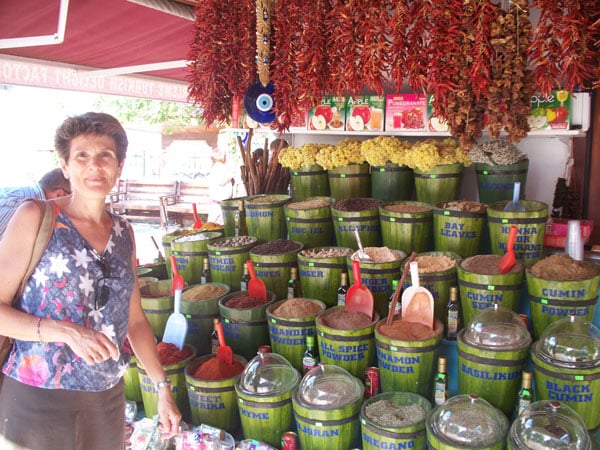
Carrie Fletcher
We anchored at Tomb Bay. Rick took us by dinghy to the beach, and then we scrambled up the dusty, rocky goat path past gnarled tree roots, sage, thyme, and miniature holly. In no time, we reached an ancient vault, stepped inside, and snapped several of those “wish you were here” type of shots, with the cat and the kayaks in the background. We picked our way down among the tangled roots and instead of waving for Rick to retrieve us, swam back to the boat, where Jane and Rick handed down icy cans of Effes, the trademark brew of the land.
I floated in a pink water toy Carrie had brought along. With my hand clutched around the light pilsner, something Sue had said at the start of the trip came to mind: “I told my family that the boat’s name is Therapy,” she’d said. “So I should be all fixed by the time I get home.”
On that boat, in this country, with these fine friends, I was starting to feel pretty fixed myself.
CW deputy editor Elaine Lembo writes frequently about chartering.








